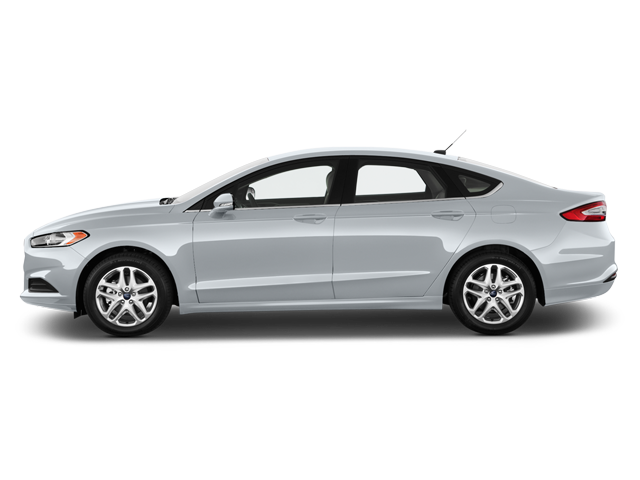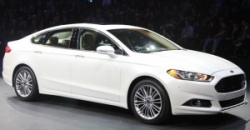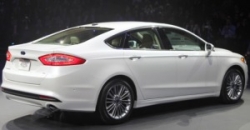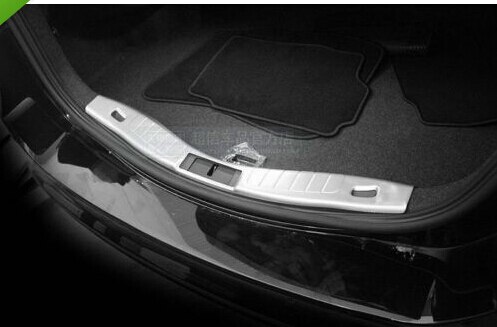2014 Ford Fusion Titanium Top Speed
The 2014 Ford Fusion Titanium is a All-wheel drive Sedan. It can accommodate up to 5 passengers. It has 4 Doors and is powered by a 2.0L L4 Ti-VCT GTDI engine which outputs 231 hp @ 5500 rpm and is paired with 6-speed automatic transmission with manual mode gearbox. The 2014 Ford Fusion Titanium has cargo capacity of 453 Liters and the vehicle weighs 1554 kg. In terms of ride assists, the 2014 Ford Fusion Titanium has stability control and traction control in addition to anti-lock brake system (ABS). The vehicle has an optional engine as well It offers Parking distance sensor and Rear view camera. Safety features also include Driver side front airbag and Passenger-side front airbag. The front suspension is Front independant suspension while the rear suspension is Independent rear suspension. The car also features a Low tire pressure warning It has 18'' painted alloy wheels as standard. Electronic features include Cruise Control. For convenience, the car has Power windows and Power door locks. There is also a remote keyless entry feature. Moreover, the car has Remote engine starter. The steering wheel has audio control buttons. In terms of performance, the car has 252 N.m of torque and a top speed of 225 km/h. The 2014 Ford Fusion Titanium accelerates from zero to 60 mph in 7.1 seconds and hits quarter mile at 13.6 seconds. Fuel consumption is 9.2 L/100km in the city and 5.9 L/100km in the highway. The car price starts at $ 33,999
2014 Ford Fusion 2.0l Ecoboost 0-100 MPH Acceleration
2014 Ford fusion 2.0L Ecoboost 0-60 time with StopWatch
2014 Ford Fusion Hybrid Acceleration Test
2017 Ford Fusion VS Mazda 3 2014. Drag race!!
2014 Ford Fusion 1/4 Mile
2014 Ford Fusion Used Price Estimates
Estimates based on a driving average of 12,000 miles per year
| Used Condition | Trade In Price | Private Party Price | Dealer Retail Price |
|---|---|---|---|
| Outstanding | $ 7,559 | $ 9,367 | $ 11,071 |
| Clean | $ 7,178 | $ 8,902 | $ 10,498 |
| Average | $ 6,416 | $ 7,972 | $ 9,354 |
| Rough | $ 5,654 | $ 7,042 | $ 8,209 |
That's really our only major complaint about the Fusion, though. Overall, the Ford's combination of classy styling, competitive fuel economy and useful features puts it right near the top of the midsize-sedan class for 2014. You'll see some familiar names here, including the Honda Accord, Kia Optima, Mazda 6, Nissan Altima, Toyota Camry and Volkswagen Passat. Each of these cars has certain advantages, but shoppers looking for a family sedan that provides an engaging driving experience, high-end technology options and head-turning looks will be well served by the 2014 Ford Fusion.

The 2014 Ford Fusion is a four-door, five-passenger midsize sedan available in three trim levels: S, SE and Titanium.

The Fusion S comes standard with the 2.5-liter four-cylinder engine, 16-inch steel wheels, automatic headlights, full power accessories, an integrated blind-spot mirror, keyless entry, cruise control, air-conditioning, a tilt-and-telescoping steering wheel, a trip computer, 60/40-split-folding rear seats, the voice-activated Sync audio and cell phone interface, and a four-speaker sound system with a CD player, auxiliary audio jack and a USB port/iPod interface.

Moving up to the Fusion SE gets you 17-inch alloy wheels, exterior keypad entry, heated mirrors, an eight-way power driver seat (with power lumbar), rear air ducts, a rear fold-down armrest and a six-speaker sound system with satellite radio.

The SE is also eligible for additional optional equipment. The Appearance package adds 18-inch alloy wheels, a rear spoiler, foglights, a leather-wrapped steering wheel and special cloth upholstery. The Luxury package adds auto-dimming mirrors, leather upholstery, heated front seats, driver memory settings and a four-way power front passenger seat.

Opting for the SE's Technology package equips the Fusion with dual-zone automatic climate control, the MyFord Touch electronics interface (with 8-inch central LCD touchscreen and two 4-inch configurable gauge cluster displays), an upgraded version of Sync, two USB ports, an SD card reader, RCA video input jacks and a rearview camera. Keyless ignition/entry and rear parking sensors are also optional for the SE.

The Fusion Titanium comes standard with the turbocharged 2.0-liter engine, 18-inch wheels, a sport-tuned suspension, remote start, sport front seats, a premium 12-speaker Sony sound system, HD radio and all of the SE's optional features mentioned above.
The Fusion SE (with the Technology package selected) and Titanium can also be equipped with a navigation system, an automated parallel-parking system, a heated steering wheel and adaptive cruise control with collision warning and brake intervention. For the SE and Titanium, Ford additionally offers the Luxury Driver Assist package, which includes automatic high-beam control, a 110-volt power outlet, blind-spot monitoring, rear cross-traffic alert and lane-departure warning and lane assist. A sunroof is optional for both the SE and Titanium, and the Titanium can be had with 19-inch wheels and ventilated front seats.
The Fusion S and SE come standard with a 2.5-liter four-cylinder engine that's rated at 175 hp and 175 pound-feet of torque. Power is sent to the front wheels through a six-speed automatic transmission.
For the SE, there are three engine options. There's a turbocharged 1.6-liter four-cylinder that produces 178 hp and 184 lb-ft of torque. It comes with a six-speed manual transmission only. Considering that, we expect the more popular option to be the new turbocharged 1.5-liter four-cylinder, which comes matched to a six-speed automatic. Power output is an estimated 178 hp and 177 lb-ft of torque.
Those looking for maximum thrust should consider the turbocharged 2.0-liter four-cylinder with 240 hp and 270 lb-ft of torque. It also comes only with the six-speed automatic (with paddle shifters). The Fusion Titanium comes standard with the turbocharged 2.0-liter engine and automatic. All-wheel drive is optional for the Titanium as well.
In prior track testing, a 2013 Ford Fusion with the 1.6-liter and automatic transmission (a combination no longer available) went from zero to 60 mph in 8.8 seconds, which is average for four-cylinder family sedans. This year's 1.5-liter engine and auto should be pretty much identical. A Fusion Titanium with the turbo 2.0-liter and all-wheel drive accelerated from zero to 60 mph in 6.9 seconds, which is on par with V6-equipped AWD sedans in this price range.
Official EPA-estimated fuel economy stands at 26 mpg combined (22 mpg city/34 mpg highway) with the 2.5-liter engine, which is average for this class. Both the 1.5- and 1.6-liter engines feature automatic engine stop-start functionality (like a hybrid) to optimize fuel economy. The 1.6 earns 29 mpg combined (25 mpg city/37 mpg highway), while the 1.5 is just slightly less at 28 mpg combined (23 mpg city/36 mpg highway).
Front-wheel-drive 2.0-liter-equipped Fusions earn 26 mpg combined (22 mpg city/33 mpg highway), while the AWD Titanium rates 25 mpg combined (22 mpg city/31 mpg highway).
The 2014 Ford Fusion comes standard with antilock disc brakes, traction and stability control, front seat side airbags, front knee airbags and side curtain airbags. The Ford Sync system includes an emergency crash-notification feature that automatically dials 911 when paired with a compatible cell phone. Also standard is Ford's MyKey, which can be used to set certain parameters for teen drivers.
Optional equipment includes blind-spot monitoring, rear cross-traffic alert, driver-drowsiness detection and lane-departure warning, lane-keep assist, collision warning (with brake intervention) and inflatable rear seatbelts.
In brake testing, a Fusion Titanium stopped from 60 mph in 123 feet, an average distance for this class of car.
The government gave the Fusion five out of five stars for overall crash protection, along with five stars for frontal protection and four stars for side protection. The Insurance Institute for Highway Safety gave the Fusion the highest possible rating of "Good" in its moderate-overlap frontal-offset, side-impact and roof strength crash tests. In the institute's new small-overlap frontal-offset test, the Fusion earned a second-best rating of "Acceptable."
It's impossible to go wrong with any of the 2014 Ford Fusion's engine choices. Even the base 2.5-liter engine offers competitive power, while the optional turbocharged engines provide an appealing blend of fuel efficiency and performance. The 1.5- and 1.6-liter engines are likely the best bets for most buyers, and they make the Fusion feel quicker than our acceleration testing numbers indicate.
On the highway, the 2014 Ford Fusion offers a comfortable and controlled ride. It's also remarkably quiet. What's really nice, however, is that these qualities don't come at the expense of engaging handling. Driven through turns, the Fusion is confident and composed, and the steering is remarkably communicative.
Inside the 2014 Ford Fusion, tasteful style and high-quality materials abound. The dashboard and center stack are uncluttered and tastefully designed, although this down-to-business decor can also come across as stark and uninviting, especially with the all-black interior.
With the highly adjustable power driver seat, just about everybody should be able to find a comfortable driving position. The passenger seat is just as supportive, while the split-folding rear seats are well contoured and have plenty of legroom. The Fusion's swoopy styling cuts down on rear headroom a bit, but it's still comparable to its competition, with enough clearance for normal-size adults.
If there is one area in which the 2014 Ford Fusion shines, it's the car's athletic driving character. The base 2.5-liter 4-cylinder isn't going to win you any drag races, but even at that level, the Fusion's excellent suspension setup gives it small-car handling in a big package. Move up to the 1.5-liter and 1.6-liter turbo engines and your inner enthusiast will be most pleased, especially considering you can still get a manual transmission on the SE model. But, it's the 2.0-liter turbo with its 240 horsepower that will make the most ardent V6 fan capitulate to this engine's superiority. The Fusion Hybrid system's transition between the gasoline engine and electric motor is nearly seamless, and the car can travel up to 62 mph on electric power alone. The Energi plug-in hybrid's electric-only top speed is 85 mph, and the car is rated to travel up to 21 miles on electricity alone and up to 620 miles total.
HYBRID VERSIONPerhaps the best thing about the hybrid version of the Fusion is that you may not know it is one until you realize how little fuel you're using. The Fusion Hybrid yields an EPA-estimated 47 mpg combined, and is a smooth operator while earning that lofty figure.SMALL BUT EFFICIENT ENGINESAll of the gasoline powerplants used in the 2014 Ford Fusion are 4-cylinder engines, and all but the version in the base model are 2.0 liters or less. If that size makes you dubious, you need not be. These small engines pack a powerful punch thanks to turbocharging and direct-injection technology.
The 2014 Ford Fusion's cabin is attractive for sure, but it doesn't feel as open or wide as some of its competitors. Four adults can sit comfortably in the Fusion, or three kids can squeeze in the back seat. At 16 cubic feet, the Fusion's trunk is bigger than the Honda Accord's, but smaller than the Hyundai Sonata's. In hybrid models, some space is eaten up by under-floor batteries. Still, even hybrid models allow the rear seats to fold for added cargo room. The cloth seats and foam inserts in Fusion Hybrid and Energi models are made from recyclable or renewable materials.
We know the 2014 Ford Fusion is an affordable family sedan, but with its Aston Martin-like grille, it looks more like an expensive European luxury car. Ford adds its own subtle styling cues in the form of numerous original wheel designs, interesting colors and aggressive headlights. The clever EasyFuel capless gas filler system means you'll never again have to wrestle to open a fuel cap or wait for it to "click" into place. On Energi versions a lighted ring surrounds the charging port. The ring lights up as the car charges, with a fully lit circle indicating a full charge.
The 2014 Fusion is offered in eight trims: The gasoline and hybrid models are S, SE and Titanium, while the Energi is limited to SE and Titanium. Base S models include manual climate control, a tilt/telescoping steering wheel, a 4-speaker AM/FM/CD player with auxiliary input, 16-inch wheels, and Ford's SYNC wireless communication system with voice control. SE models add 10-way power driver's seat, rear air vents, a 6-speaker audio system, and 17-inch wheels. Moving up to the Titanium model nets the powerful 2.0-liter turbocharged engine, 12-speaker Sony premium audio system with HD and satellite radio, dual-zone auto climate control, a rearview camera, leather seating, and 18-inch wheels.
In addition to more powerful turbocharged engines, features available on the 2014 Ford Fusion emphasize technology for making the car safer and commutes more comfortable. Among the offerings are a reverse-sensing system, Active Park Assist to help with parallel parking, adaptive cruise control, a navigation system, and a blind-spot monitoring system. One particularly interesting and potentially life-saving feature is the Lane Keeping System. Using a windshield-mounted camera, the car keeps a digital eye on road markings to detect if the car drifts into another lane. If that happens, the system alerts the driver by sounding a warning, vibrating the steering wheel and, ultimately, applying steering torque to get the car back into the lane.
Henry Ford started the company in 1902 with $ 28,000 in cash from twelve investors, among which were John and Horace Dodge, who would later found the Dodge Brothers Motor Vehicle Company. He was 40 years when he first established the company's first factory on Bagley Street, Detroit.
He would later incorporate the firm on June 16, 1903. Ford Motor Company would go on and label their models chronologically in alfabetical order, starting with the Model A to the Model K and Model S, which was Ford's last right-hand steering vehicle. Then, in 1908 Ford introduced the Model T, which was designed by Childe Harold Wills and two Hungarian immigrants, Joseph A. Galamb and Eugene Farkas. This model proved to be of quintessential Ford vehicle, placing the company among the most influential automotive brands in history.
The Ford Model T was reliable, practical and affordable, which made it a big hit in the US, where it was advertised as the middle-class man's vehicle. The car's success compelled Ford to expand his business and layout the basics of mass production principles in 1913 with the introduction of the world's first vehicle assembly line. By 1912, production figures for the Model T alone reached nearly 200,000 units.
This organizational innovation brought in the vehicle construction field allowed Ford to reduce chassis assembly time by as much as 10 hours, dropping from 12 ½ h to 2h 40 min.
Besides ensuring the efficiency of the production process, Ford turned his company into an interactive entity by announcing a new profit-sharing policy. This would grant buyers a cut of profits if sales reached 300,000. As expected, sales effortlessly reached the 300k threshold and went even further to hit a record 501,000 in 1915.
As part of a new set of financial tactics, Ford provided working places for the disabled who otherwise had a hard time finding a job, reduced work shifts and doubled all employee's salaries. Changes like these sparked a tremendous sales increase while also setting the base of modern working conditions.
Still, the US and Canadian market would prove to be too small to fit Ford's plans. By the mid 20's, the Ford label had crossed the ocean and reached England, France, Germany, Denmark, Austria as well as distant Australia. The company's activity on European grounds further helped the brand's revenue growth.
War would not shake the Ford company as bad as other car makers. Post WWI improvements include the introduction of four-wheel brakes and a series of new vehicle releases to match new consumer demands. In 1922 Ford entered the luxury car segment with the acquisition of the Lincoln Motor Company, named after Abraham Lincoln whom Henry Ford admired.
Ford Motor Co. was one of the few big American corporations to survive the Great Depression, although the plummeting automotive sales led the company to scale down its operations and lay off many workers. In May 1929, Ford Motor Co. signed an agreement with the Soviet Union to provide technical assistance until 1938 to construct an integrated automobile-manufacturing plant at Nizhny Novgorod, in exchange for the Soviets purchasing $ 13 million worth of automobiles and parts. Under this agreement many American engineers and skilled auto workers went in 1932 to work on the Gorkovsky Avtomobilny Zavod (GAZ), or Gorki Automotive Plant. The few who remained in the Soviet Union after the completion of the plant fell victims to Stalin's Great Terror, ending either shot or exiled to Soviet gulags.
With the arrival of WWII Ford increased its influence on the global stage becoming an active player in the war effort, a thing underlined by US President Franklin Roosevelt referring to Detroit as the "Arsenal of Democracy." When the US War Department handed production of B-24 Liberator airplanes to Ford, the output rose to 20 airplanes per day instead of only one per day managed by the Consolidated Aircraft Corporation.
After WWII Ford continued its passenger vehicle operations and in 1955 introduced the iconic Thunderbird model. Then it introduced the Edsel brand in 1958, which proved to be a failure and was dissolved in 1960. Part Edsel's failure as an automotive brand resided in the onset of the 1957 recession in the States and the vehicle's high price tag.
Ford Motor Co. managed to get back up from its Edsel failure with the introduction of the Falcon model in 1960 and the Mustang in 1964. The company's next major step was represented by the formation of Ford Europe division in 1967.
Ford plunged into a state of brand-fatigue that would bring the company to the point of near bankruptcy. Following major sales losses in the 2000's, Ford was pinned against the wall by debts and the imminence of closing down.
Preferring to make it back on its own, Ford mortgaged all of its assets in 2006. As of then, the company has releases a variety of new models both under the Ford brand name and the rest of the sub-brands it owns such as fresher and edgier Mercuries and flashier Lincolns, Ford's luxury division. Business in Europe has also been good for Ford, especially after the introduction of the Focus model in 1997 and although it hasn't fully recovered, it's definitely on the way to regaining popularity.
2014 Ford Fusion Titanium Top Speed
Source: https://www.mycarspecs.com/car/2014-ford-fusion-base-titanium

0 komentar:
Posting Komentar